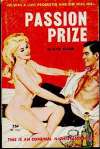From sleazy and how!:
I’m a sucker for a sleazy mystery or a trampy romance novel from the 1950’s-60’s. I usually buy these silly books more for the covers than the stories, but sometimes both are equally bizarre.
This is a gallery of some of the better books I’ve come across. Some have book summaries, others I just liked the covers.
 Here are some of the ones I liked: Women’s Doctor. Chinese Lover. Come Sin With Me. Studio Apartment. Musk, Hashish and Blood.
Here are some of the ones I liked: Women’s Doctor. Chinese Lover. Come Sin With Me. Studio Apartment. Musk, Hashish and Blood.
Frenchie, with this exciting passage: “He was all ready to go. The easel was under one arm. Suddenly she couldn’t think about what she should have done. There was no right or wrong way to act, there was only one way. She ran to him and pulled him down toward her. Her fingers bit into his arms. ‘No, no,’ she murmured brokenly. ‘You mustn’t go. You can’t. I couldn’t live…'”.
Illicit Desires, which includes this blurb: “Passion’s Slaves! There’s many a sizzling tale about the ‘farmer’s daughter’, but never has the truth been told so revealingly as in this story of Eva, a member of ‘Ja-Ja” Steinhart’s household; of Mazie, her buxom, full bosomed rival, and their spirited fight for their mutual lover, Joe.”
And Call Her Wanton (“She was fair…she was frisky…she was oh, so much fun…A lusty novel of wilderness passion and a wife too naughty to be true!”).
Or The Manatee (“He had a passion for his ship’s figurehead that no living, breathing woman could satisfy.”).
I think the prize for blurb writing goes to Shady Lady: “Some people called Leslie Fentris a shady lady and most people thought that was putting it mildly. She had money and brains, and plenty of lure. Yet she was mixed up in one shameful scandal after another. Actually, she was a fine and honest person who acted the way she did for very good reasons.
 Here are some of the ones I liked: Women’s Doctor. Chinese Lover. Come Sin With Me. Studio Apartment. Musk, Hashish and Blood.
Here are some of the ones I liked: Women’s Doctor. Chinese Lover. Come Sin With Me. Studio Apartment. Musk, Hashish and Blood.